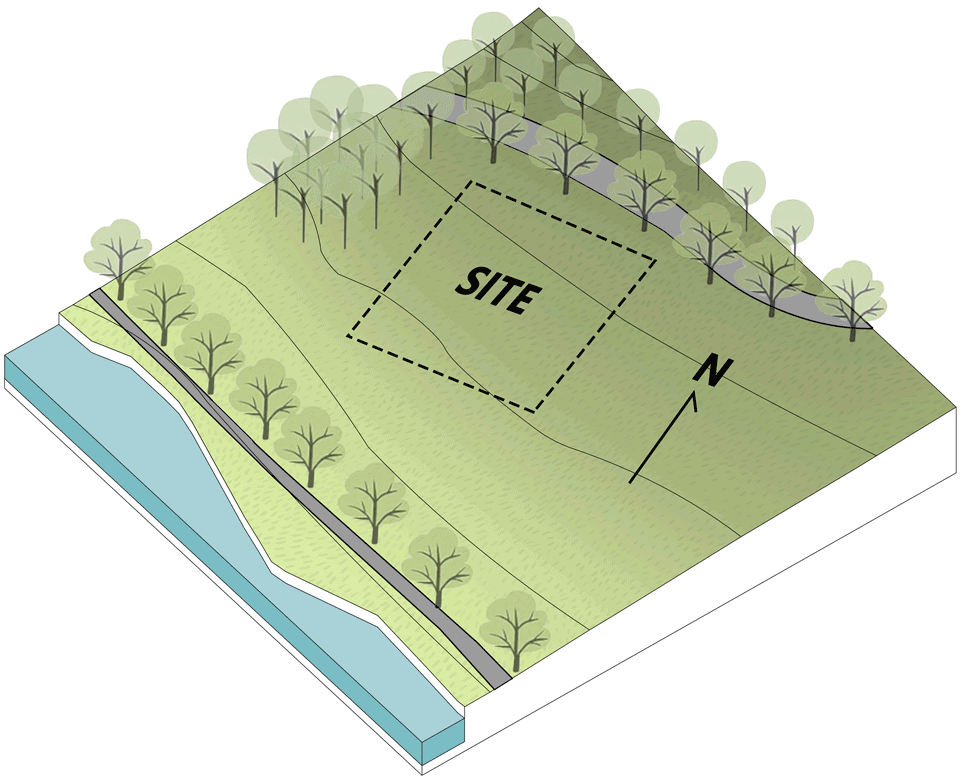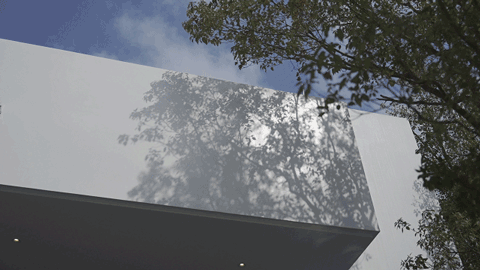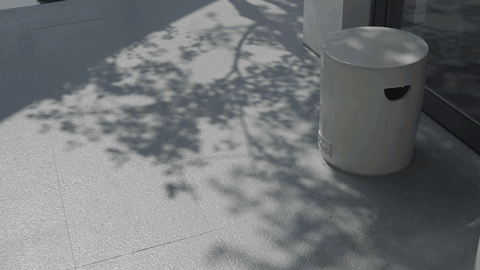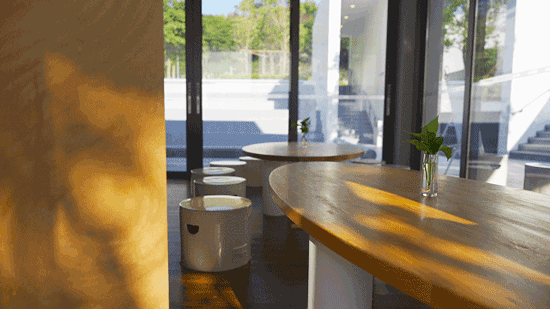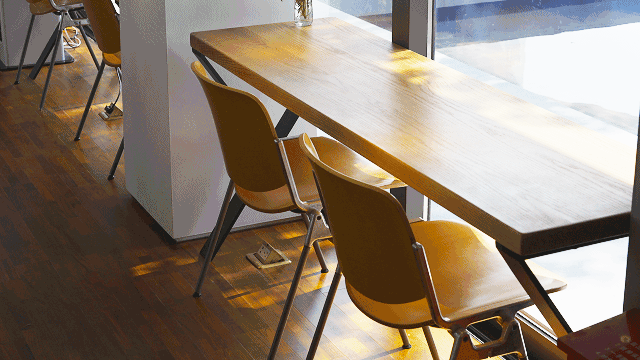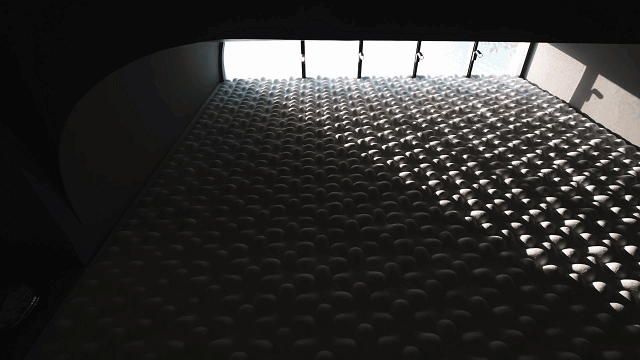查看完整案例

收藏

下载
概况
Overview
紫马岭香山书房项目用地位于广东中山紫马岭公园一面大草坪内,目标是在此建设一栋集阅读、文化交流展示、轻餐饮为一体的复合型书房。
项目于2022年4月构思9月开工,2023年1月18日紫马岭香山书房正式对市民开放。
The project, Zimaling Xiangshan Study, with its site located in a grand lawn in the Zimaling Park, Zhongshan, Guangdong,is to construct a compound study integrating reading, cultural exchange and exhibition as well as light catering.
The project was conceived in April 2022, started in September and opened on January 18, 2023 officially to citizens.
▼项目外观,Exterior view
建筑构思
Architectural conception
我们选择较为安静的草坪西侧作为具体的建设场地,在保证草坪的完整性的同时让建筑更好地成为草坪的视觉焦点。
West of the land is selected as the specific place for the construction as it is quieter. It can guarantee the integrity of the lawn while turning the building into the visual focus of the lawn better.
▼鸟瞰图,Aerial view
– 现状:建筑场地位于公园大草坪地一端,北面靠水、南向面水、西接树林、东朝大草坪。
– 隐藏:将建筑部分埋入土中,削弱建筑在草坪中的体量感;此外使得北面园路可以轻松地到达一层屋面。
– 庭院:将建筑体量进行掏空和围合处理,创造出大大小小的庭院,为建筑提供足够的采光同时也将绿化引入室内,营造园中园的效果。外围的圆弧形围合也柔和-了建筑的边界,以一个更加亲切的姿态融入草坪。
– 引入:连接南北园路,同时在建筑东侧、西侧和南侧设置开口,吸引草坪的人流。于北侧设置大阶梯,保证上下层空间的连续性,为北侧主园路提供便捷直接的入口,同时结合庭院营造了下沉阶梯广场空间。
– 二层:局部增加二层体量,同时利用一层屋面和弧形外墙创造两条有趣的无障碍通道进行连接。
– 转变:对二层体量进行形态转变,设置双向的坡屋顶。北向坡屋顶为二层入口提供引导强调的作用。东西向坡屋顶则面朝草坪,为建筑提升标识性和仪式感。
– 细节:在生成体量的基础上加入栏杆、片墙、台阶、树池、烟道、窗洞等细节构件。
– 植树:在建筑特意留白的庭院空间及外围的绿化池中,植入15棵樟树、22棵白兰树,进一步地削弱建筑地体量感,同时创造园中园的空间,将绿化引入室内,既隐约又外部自然景观进行呼应。
▼场地示意图,Site schematic diagram
– Status quo: The construction site situates at one end of the grand lawn of the Park,with its north adjacent to the water, south facing the water, west connected to the woods and east towards the grand lawn.
– Hidden: Parts of the building are buried in the earth to reduce the volume sense of the building in the lawn and enable the north path to access to the first floor.
– Courtyard: The building volume is hollowed out and enclosed to create large and small courtyards, so as to provide enough lighting for the building and to introduce the greening into the interior, creating the effect of the garden within the garden. The circular enclosure of the periphery also softens the boundary of the building and fits into the lawn in a more friendly manner.
– Introduction: It is connected to the south and north park paths, with openings on the east, west and south sides of the building to attract the flow of the lawn. A large ladder is set on the north side to ensure the continuity of the upper and lower layer space, providing a convenient and direct entrance for the main garden road on the north side. Meanwhile, the sunken step square space is created combined with the courtyard.
– Second Floor: The volume of second floor is partially increased, while the first floor and curved exterior wall are used to create two interesting barrier-free channels for connection.
– Transformation: The shape of the second-floor volume is transformed in form with a two-way slope roof set up. The north slope roof provides guidance and emphasis for the second floor entrance. The east-west sloping roof faces the lawn, enhancing the identity and ritual sense of the building.
– Details: on the basis of generating the volume, railings, wall, steps, tree pool, flue, window hole and other detailed components are added.
– Tree planting: 15 camphor trees and 22 orchid trees are implanted in the specially reserved courtyard space and the peripheral green pool, which further weakens the volume of the building, while creating the space of garden within the garden to introduce the greening into the interior, which is both implicit and echoes the external natural landscape.
▼分析图,Diagram
建筑与自然的交互共生
The interactive symbiosis of the building and nature
建筑与自然是相互共生的,一方面建筑刻意地通过围合与掏空创造了许多庭院空间,为自然提供了生存空间,引入大量阳光空气与绿化。同时绿化也在白色外墙和窗洞的衬托下显得更加有诗意。另一方面,自然的介入为建筑带了更多的绿意与生机,且流动的阳光空气也为建筑的低碳环保节能提供了条件。
The building and nature are symbiotic with each other. On the one hand, the building is deliberately created with a lot of courtyard spaces through enclosure and hollowing, providing living space for nature and introducing plenty of sunshine, air and greening. Meanwhile, the greening is also more poetic against the white exterior wall and window holes. On the other hand, the intervention of nature brings more green and vitality to the building, and the flow of sunshine and air also provides conditions for the low carbon, environmental protection and energy saving of the building.
▼庭院光影 & 跌水池,Courtyard light and shadow & Water descending pool
天井与院落栽种了37棵树,树的青翠和绿意晕染在行人身上,令游人在建筑内产生仍身处自然之中的感觉。自然光将碧水与树影映射在建筑上,白墙上的流动“墨痕”肌理赋予了建筑更多的活力。
Thirty-seven trees are planted in the patio and courtyard. The freshness and greenness of the trees are stained on pedestrians, making visitors feel that they are still in nature even they are in the building. Natural light maps the clear water and the trees on the building, and the flowing “ink mark” texture on the white wall gives the building more vitality.
▼弧形坡道景窗,Arc ramp view window
▼树影,Shadow of the leaves
建筑各异的窗洞是介入自然的媒介,在游走的过程中游人会在这些特设的“画框”中收获意想不到的画面与惊喜。绿意在半遮半掩的白色弧墙中漏出,软化了建筑的同时,让外部游人更加好奇建筑的内部空间。
The window holes of different styles are the medium to intervene in nature. In the process of walking, people will witness unexpected pictures and surprises in these special “picture frames”. The greenness leaks out in the half-covered white arc wall, which softens the building and makes the outside visitors more curious about the interior space of the building.
▼白色弧墙,The white arc wall
灵活立体的空间
Flexible stereo space
建筑空间的处理是丰富灵活、错落有序的。游人在多变的空间中穿行,步移景异,会更加有趣、兴奋。
The processing of architectural space is rich and flexible, scattered and orderly. In the changeable space through, visitors can move with different scenery, and feel more interesting and exciting.
▼流线分析图,Streamline analysis diagram
▼外廊,Outdoor gallery
灵活立体的动线设计,将这些错落的空间串联起来,创造了更多人与人在空间中相遇和社交的可能性。
The flexible and three-dimensional dynamic line design connects these scattered spaces, creating the possibility for more people to meet and socialize in the space.
▼错落的空间,The scattered spaces
标识性
Identifying
建筑选用白色作为主色调,一是在大草坪的环境中,希望建筑是简洁干净的。二是白色能让建筑的线条和边界更加干练,雕塑感和标识性更强。
White is the main color of the building for the reason that firstly it is hoped that the building is simple and clean in the environment of the lawn. Secondly, white can make the lines and boundaries of the building sleeker, and the sense of sculpture and logo are stronger.
▼白色外观,The white appearance
同时白色墙体与自然的搭配也中国传统园林的主调,进入建筑之中,如漫步于二十一世纪的岭南书院,既有步移景异、围而不合的现代园林感受,亦有空间穿插、光景变换的当代建筑体验。
Besides, the collocation of white walls and nature is also the main tone of the traditional Chinese gardens. Entering the architecture is just like waling in the Lingnan College of the 21st century, enjoying both the modern garden experience of different scenery in marching and the contemporary architectural experience of space interspersed and changing scenery.
▼二层坡屋顶,Two-story slope roof
二层体量打破第五立面,设计成坡屋面,突出标识性,更能适配有仪式感的活动。
The volume of the two layers breaks the fifth facade and is designed into a slope roof, highlighting the identity and adapting to the activities with a sense of ceremony.
▼南面入口,Nouth entrance
功能空间
Functional space
建筑分为4个主题空间分别为:香山书房、香山沙龙、户外客厅、书房餐饮。
The building is divided into four theme Spaces.They are: Xiangshan study, Xiangshan salon, outdoor living room, and study catering.
▼功能分区图,Functional zoning diagram
▼东面入口,East entrance
香山书房
Xiangshan study
位于建筑南面的书房,三面透光,南北向均为可开合的玻璃门窗,可自主通风采光。契合时下环保理念,读者于其中可近观植树小院,远眺大草坪及湖光水景。
The study is located in the south of the building with three sides accepting light. In both the north and south sides, there are glass doors and windows that can be opened and closed, making it possible to achieve independent ventilation lighting. In line with the current concept of environmental protection, readers can have a close view of the courtyard with tree planted, overlooking the grand lawn and the lake waterscape.
▼香山书房南入口,South entrance of the Xiangshan Study
南面入口处展出紫马岭香山书房三次修改方案的模型,由此能感受到设计团队的设计思路变化。
At the south entrance, the model of Zimaling Xiangshan Study is displayed, which enables to feel the changes of design ideas of the design team.
▼室内空间,Interior view
书房空间选用木质材料为主,搭配上中古家具,营造了一个温馨舒适的阅读环境。
For the study space, woodiness material is dominant with furniture of the style in middle ancient times, creating a warm and comfortable reading environment.
▼室内家具细节,Furniture details
香山沙龙
Xiangshan salon
位于二层的香山沙龙,由北面无障碍坡道和外围弧形坡道进入。
Located on the second floor, the Xiangshan Salon is accessed by the north accessible ramp and the outer curved ramp.
▼香山沙龙北入口,North entrance of Xiangshan Salon
室内白墙体及金字屋顶空间,富有仪式感,适合不定期举办小型展览及各种仪式感的小型社交活动。
The indoor white wall and gold roof space generate a sense of ceremony, which is suitable for irregular small exhibitions and various small social activities with a sense of ceremony.
▼活动空间,Activity space
▼左:展览空间;右:东面窗口与公园高塔互望关系,Left: exhibition space; Right: the east window and the park tower look at each other
户外客厅
Outdoor living room
阶梯式户外广场空间,通天地贯东西,藏风聚气。既保持了周边环境的连续性,又将建筑“自然”地带入到自然环境当中。
Stepped outdoor square space welcomes the sky and the ground, and connects the east and west, with wind ushered in and gas gathered. It not only maintains the continuity of the surrounding environment, but also brings the building “naturally” into the natural environment.
▼户外广场空间,Outdoor square space
东北角户外客厅,由阶梯式讲座空间及居中的多功能广场组成。可以承载阅读交流,才艺表演等功能。
The outdoor living room in the northeast corner is composed of a stepped lecture space and a multi-functional square in the center. It can carry the reading communication, talent show and other functions.
▼阶梯式讲座空间,Stepped lecture space
▼乐队表演,Band performance
书房餐饮
Study catering
于西南面的书房餐饮设计有两采光通风天井。
In the southwest, the study catering venue is designed with two patios of lighting and ventilation.
▼西南面天井,South-west patio
微风树影令青年人乐聚其中,品茶啜啡,谈书论艺。书房餐厅内使用的椅子亦为的中古家具。
The breeze and tree shadow attracts young people to enjoy gathering to appreciate tea and coffee, talk about books and art. The chairs used in the study dining room are also of the style in middle ancient times.
▼微风树影,The breeze and tree shadow
除香山书房空间展陈的5000册图书外,书房餐饮内亦藏书逾3000册。
In addition to the 5000 books displayed in the Xiangshan study, there are more than 3000 books in the study catering venue.
▼书房餐饮天窗,Study catering sunroof
整幢香山书房建筑充分利用数百平方米面积,营造错落丰富的空间,灵活立体的动线和简约干练的造型。打造草坪上的新时代岭南书院,为公园游人提供一个休憩和静下心阅读的场所。
The whole Xiangshan study building makes full use of hundreds of square meters of area, creating scattered and rich space, in flexible three-dimensional dynamic line and simple and sleek shape. It is a modern Lingnan College on the lawn in the new era which provides a place for park visitors to rest and calm down to read.
▼书房夜景,The study in the evening
▼首层平面图,1F Plan
▼屋面平面图,Roof Plan
▼立面图,Elevations
▼剖面图,Sections
项目名称:紫马岭公园香山书房
项目类型:文化建筑
设计方:广东中山建筑设计院股份有限公司
项目设计:2022
完成年份:2022
项目建筑师:方雄武
主创建筑师:黄品彰
建筑设计: 黄品彰 方翰哲 徐秋惠 李中威
委托方:中山市代建项目管理办公室
结构设计: 林可勃 陈晓波
景观设计: 黄品彰
机电设计:林智彪 陈钦鸿 陈英 林菲 杨伟堃
项目地址:广东中山紫马岭公园
建筑面积:611㎡
材料:混凝土 白色涂料
Project name:Zimaling Xiangshan Study
Project type:Culture Architecture
Design: Guangdong Zhongshan Architectural design Institute CO.,LTD
Design year:2022
Completion Year:2022
Project Architect:Fang Xiongwu
Lead Architect:Huang Pinzhang
Architectural design: Huang Pinzhang,Fang Hanzhe,Xu Qiuhui,Li Zhongwei
Structural design: Lin Kebo, Chen Xiaobo
Landscape design: Huang Pinzhang
Mechatronics design:Lin Zhibiao, Chen Qinhong, Chen Ying, Lin Fei,Yang Weikun
Project addres:Zimaling Park,Zhongshan,GuangDong
Gross built area: 611.㎡
Materials: concrete; White paint














